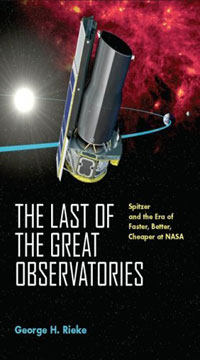Review: The Last of the Great Observatoriesby Jeff Foust
|
| Keeping the project alive required a combination of good management, lobbying of key members of Congress, and technical innovations that squeezed more out of the mission even as its budget shrank. |
Rieke provides an insider’s account of the extended effort to get SIRTF off the ground. For much of its early history, the spacecraft design was a moving target: SIRTF evolved from an instrument platform mounted in the shuttle’s cargo bay to a free-flyer launched by the shuttle, and later by a shrinking series of expendable boosters: Titan, then Atlas, and finally a souped-up Delta 2 that placed the spacecraft in a heliocentric orbit that slowly drifted away from the Earth. Those changes were forced upon the program by changing budgets and political pressures on the agency in general and SIRTF in particular. Keeping the project alive required a combination of good management, lobbying of key members of Congress, and technical innovations that squeezed more out of the mission even as its budget shrank.
While SIRTF dates back more than 20 years before its launch, it did not get its formal “new start” as a NASA mission until 1998. By that point the “faster, better, cheaper” (FBC) management philosophy of then-administrator Dan Goldin was in full force at NASA, and SIRTF was caught up in it along with many other science missions at the time. Rieke devotes considerable attention in the book (as well as an entire appendix at the end) to how this management technique worked for Spitzer. He found that the university-led teams that developed two of SIRTF’s three instruments were much better able to operate under FBC than the third, NASA-led instrument team, not to mention the aerospace companies building the telescope and spacecraft. By the latter stages of SIRTF’s development, though, the limits of FBC had become evident with the failures of missions like the Mars Climate Orbiter and Mars Polar Lander, which tried to do too much with too little money, and SIRTF drifted back into a more traditional management style.
Perhaps the most interesting aspect of The Last of the Great Observatories is seeing the multiple roles that Rieke, a scientist by profession, is forced into in order to ensure the success of his mission. Throughout the development of SIRTF he is primarily a manager overseeing development of his instrument, as well as a lobbyist selling the mission to skeptical members of Congress; his job as an astronomer is secondary, at best. That shows in the book, which discusses only in passing the scientific importance of SIRTF and infrared astronomy in general, although a chapter at the end of the book discusses the results of SIRTF/Spitzer’s first year in space. That selection of priorities is understandable, though, since the compelling story here is all the work that goes into developing a mission that can generate useful science, a process that, as it turns out, took far longer than Spitzer will likely operate.
